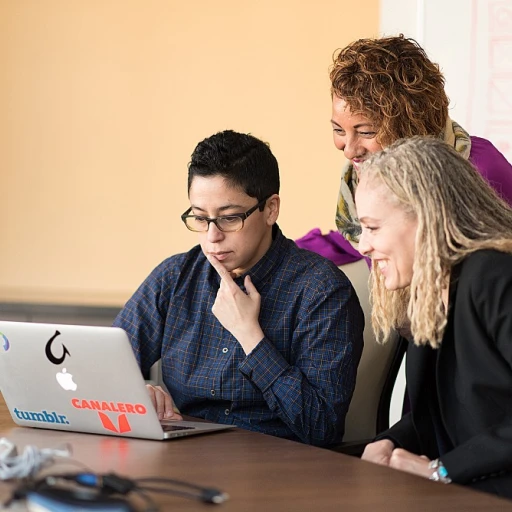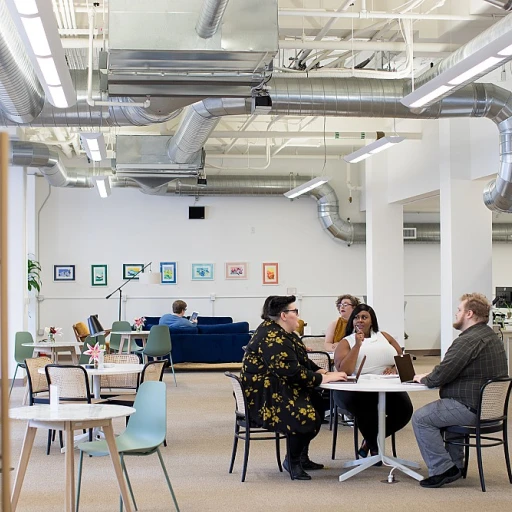The Need for Collaborative Hiring in Today's Recruitment
Increasing the Efficiency of Recruitment Efforts
In the fast-paced world of recruitment, the demand for adaptable and effective hiring practices is more crucial than ever. As organizations grow, maintaining a streamlined approach to hiring becomes increasingly complex. This is where collaborative hiring tools come into play, offering a solution that aligns with modern recruitment needs.
The traditional recruitment process often involves siloed activities that can lead to disjointed communication within and across hiring teams. This not only impacts efficiency but can also result in missed opportunities for connecting with top talent. Introducing a collaborative approach allows for integration of diverse perspectives, ensuring that each candidate is evaluated thoroughly and fairly.
A major benefit of collaborative hiring is the involvement of multiple team members in the decision-making process. This collective input leads to more informed hiring decisions, reducing the risk of bias and enhancing the likelihood of finding a candidate who fits well with the company culture and values.
Moreover,
unlocking the potential of recruitment CRM software creates a seamless experience for both recruiters and candidates. Recruitment CRM systems facilitate real-time communication between team members and provide a platform for sharing candidate information efficiently. These systems are instrumental in ensuring that every stakeholder is kept in the loop, thus safeguarding against communication breakdowns.
As you explore further in this article, you'll find how video interviews play a role in enriching the candidate experience and how applicant tracking systems can optimize the overall recruitment workflow. Embracing these collaborative hiring tools not only enhances efficiency but also creates a more inclusive and equitable hiring process.
Innovative Solutions for Collaborative Hiring
Bringing together a team to make hiring decisions requires effective tools that foster seamless collaboration. In the realm of team collaboration, certain tools stand out for their ability to facilitate communication, documentation, and decision-making among hiring teams.
- Slack: This messaging platform is a favorite among tech companies for its ability to create channels for specific recruitment campaigns, share candidate profiles, and hold discussions. With its integration capabilities, you can share files directly from your Applicant Tracking System (ATS) and tag teammates for insights.
- Trello: Known for its visual approach to task management, Trello can be utilized to track the progress of candidates through various hiring stages. Team members can comment on cards, attach documents, and vote on candidates, enhancing decision-making.
- Google Workspace: The suite offers tools like Google Docs and Sheets, enabling real-time collaboration. Hiring teams can co-edit documents, share feedback, and maintain a centralized file repository essential for recruitment.
Building a Collaborative Environment
Emphasizing open communication and teamwork is essential in the hiring process. These platforms are designed to reduce the silos of information, allowing your team to focus on evaluating candidates more effectively.
- Encourage Feedback: Promoting a culture where team members feel comfortable sharing insights about candidates enables a multifaceted evaluation approach. Such environments benefit from using platforms that streamline feedback collection.
- Foster Inclusivity: Different viewpoints contribute positively to decision-making. Collaborative tools should be leveraged to ensure each team member's perspectives are considered, aligning with goals related to diversity and inclusion.
Moreover, these tools extend beyond just paperwork and evaluations—they are vital in engaging candidates and making the experience positive. To deepen your understanding of these engagement strategies, explore our insights on
recruitment CRM software, which can substantially enhance communication with prospective employees. This approach not only optimizes candidate engagement but also sharpens overall recruitment efficiency, leading to well-rounded hiring decisions.
Enhancing the Candidate Experience with Video Interviews
Creating a Dynamic Candidate Experience through Video Interviews
In the realm of recruitment, establishing an engaging candidate experience is paramount. With technology paving the way, video interviews have emerged as an essential tool in this endeavor. This advanced method of interviewing not only saves time but also allows talent acquisition teams to assess candidates more effectively.
Unlike traditional interviews, video interviews offer flexibility and convenience for both recruiters and candidates. When implemented correctly, they can significantly enhance the recruitment process by providing a deeper insight into a candidate's personality and communication skills. This is even more critical when recruiting for roles that demand exceptional interpersonal skills.
Furthermore, video interviews allow participation of multiple team members in real-time, strengthening the collaborative aspect of the hiring process. By utilizing secure platforms, teams can easily share insights and impressions about candidates, fostering a comprehensive evaluation process before moving to a final decision.
Offering candidates a seamless and modern experience through video interviews can set your company apart. This strategic approach not only optimizes the interview phase but also reflects positively on your organization's brand image and its commitment to utilizing cutting-edge technologies.
To delve deeper into aligning your recruitment strategies and truly mastering candidate engagement, you may want to explore
mastering candidate connections. This approach can be a game-changer in attracting and retaining top talent, ensuring a successful hiring process.
Streamlining the Hiring Process with Applicant Tracking Systems
Boosting Efficiency with Tracking Systems
Integrating applicant tracking systems (ATS) into your hiring process can significantly streamline operations and reduce manual workload. These systems provide a centralized platform for managing job applications, making it easier for teams to collaborate effectively.
An ATS offers numerous advantages, including:
- Automated Job Posting: Automatically distribute job postings across various platforms, saving time and ensuring consistent reach.
- Resume Parsing: Quickly analyze and categorize resumes, allowing for a more efficient filtering of potential candidates.
- Interview Scheduling: Simplify the coordination of interviews with automatic scheduling features.
- Analytics and Reporting: Access valuable data to help inform future hiring decisions and strategies.
By leveraging the power of applicant tracking systems, you can not only minimize time spent on administrative tasks but also improve the overall quality and speed of your recruitment process. This efficiency boost aligns perfectly with the emphasis on real-time collaboration and reducing recruiter stress, discussed earlier in the article.
For recruiters eager to foster a quicker, more organized hiring process, embracing ATS technology is a step in the right direction.
Real-Time Collaboration and Reduced Recruiter Stress
Collaborate Seamlessly to Improve Efficiency
One of the crucial advantages of collaborative hiring tools is the ability to work in real-time with your recruitment team. When everyone is on the same page, decisions can be made faster, and recruiters spend less time on repetitive tasks. Real-time collaboration means that team members can share insights, feedback, and updates immediately, keeping the process moving smoothly without unnecessary delays.
By implementing collaborative tools, teams can break down communication barriers and foster a more cohesive hiring strategy. When recruiters, hiring managers, and possibly even executives can access the same information at the same time, it helps streamline the process significantly.
Minimize Recruiter Stress with Thoughtful Tools
Reducing stress is one of the often-overlooked benefits of implementing a collaborative approach in hiring. With multiple stakeholders involved, the burden of decision-making doesn't rest on a single recruiter, allowing for shared responsibility and a more relaxed workflow.
Additionally, many collaborative hiring tools come with templates, automated notifications, and communication aids, which can help alleviate the pressure on recruiters to remember every detail. These features ensure nothing is overlooked, deadlines are met, and the candidate experience is seamless.
Encourage Feedback and Continuous Improvement
Another crucial aspect of reducing recruiter stress is embracing feedback from all team members. Collaborative tools often provide platforms for gathering insights and suggestions, creating a culture of continuous improvement.
Incorporating feedback loops into the hiring process allows teams to make data-driven decisions, adapt quickly, and refine their practices regularly. This ongoing improvement reduces errors and enhances the overall recruitment process, making it more efficient and effective for everyone involved.
Embracing Diversity, Equity, and Inclusion in Hiring
Promoting Inclusive Hiring Practices
In today's competitive job market, embracing diversity, equity, and inclusion (DEI) is not merely a strategy to enhance innovation, but a necessity to build dynamic and robust teams. The adoption of collaborative hiring tools significantly contributes to achieving DEI goals by promoting an inclusive hiring process.
One of the key aspects of fostering diversity is ensuring that unconscious bias does not creep into the recruitment process. Collaborative tools such as structured interviews and shared feedback systems help in creating objective evaluation frameworks. These frameworks allow team members to assess candidates consistently, ensuring that decisions are based on critical job-related criteria rather than personal biases.
Additionally, integrating collaborative platforms encourages participation from diverse team members. This inclusion of varied perspectives can shine a light on different candidate qualities and competencies, further supporting a balanced hiring decision.
Another powerful benefit of collaborative hiring tools is transparency. When multiple members of your team engage in the recruitment process, it brings transparency and shared accountability, which are crucial for maintaining DEI standards. Candidates can be evaluated fairly as team members can provide anonymized feedback and insights across the platform.
Finally, technology allows for scalability in your DEI efforts. Applicant tracking systems (ATS) can track diversity metrics and help organizations adapt their hiring strategies to meet their DEI objectives. Coordinating efforts through these systems ensures continuous improvement and alignment with organizational values.
To sum it up, collaborative hiring tools are instrumental in shaping a diverse and inclusive work environment. They support unbiased decision-making, leverage team insights, enhance transparency, and offer data-driven insights to fulfill your DEI commitments.











